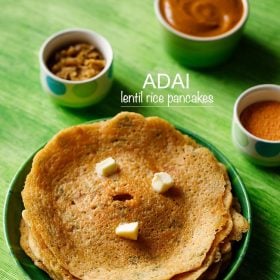
If there’s another dish that defines South India like none other, it is the dosa. Traditionally, it is a crispy, thin savory pancake that can be with or without the humble potato filling or masala. But then, if you consider fancy versions, this Mysore Masala Dosa is one of the most popular ones. It might appear similar to a regular masala dosa. But what sets this Mysore Masala Dosa Recipe apart from its counterpart is the hot red chutney that goes liberally into it. In this recipe of mine, you’ll get to know how to make this chutney too, that makes all the difference in this dish.


Like any other Mysore Masala Dosa, my version is also a crisp and soft dosa spiced with this spicy robust Red Chili Garlic Chutney and served with potato masala filling, also known as the potato palya. I usually serve it with a simple homely sambar, mint-coconut chutney, the leftover red chutney and sometimes a garlic chutney too.
The classic Mysore Masala Dosa Recipe is quite different than the ones that are available in other cities of India, especially Mumbai and Delhi. I’ve been fortunate enough to have tried this dosa both in Mysore and Bengaluru, and I can say that these are distinct than the others.


The difference actually lies in the batter of the Mysore Masala Dosa. The ones served in Mumbai and other cities apart from South India, are crisp and white like the regular Masala Dosa.
Whereas the authentic Mysore ones are crisp on the outside and have a soft, porous bite as well as texture. These also have a nice golden-brown color to them. All this is due to the addition of cooked rice or poha (flattened rice) in the batter of the Mysore Masala Dosa Recipe.


In my recipe of Mysore Masala Dosa, I have used sona masoori rice to make the batter. The batter is also fermented really well. This is an absolute essential step, not just for making this dosa, but any other dosa too. Unless of course, you are considering using a recipe to make instant dosas.
You can use any regular rice in the batter. I have also made this dosa with a 1:1 proportion of idli rice (parboiled rice) and sona masoori rice, which has worked very well.
Step-by-Step Guide
How to make Mysore Masala Dosa
- Make the potato palya or stir fry and keep ready.
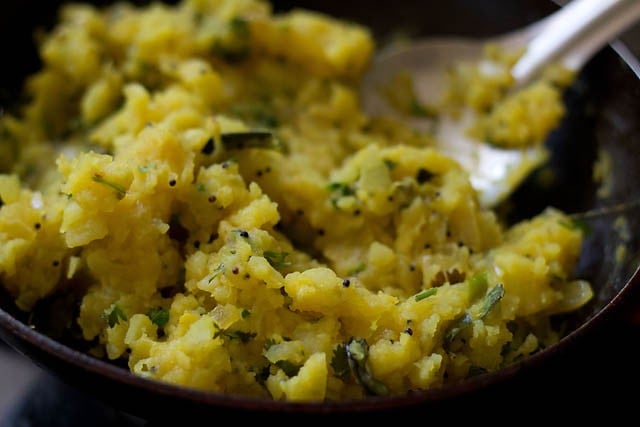

2. Heat a frying pan or tawa. Spread the dosa batter. If using non-stick pan, then don’t spread oil.


3. Sprinkle some oil on the sides of the dosa. Cover the dosa with a lid and let it cook.
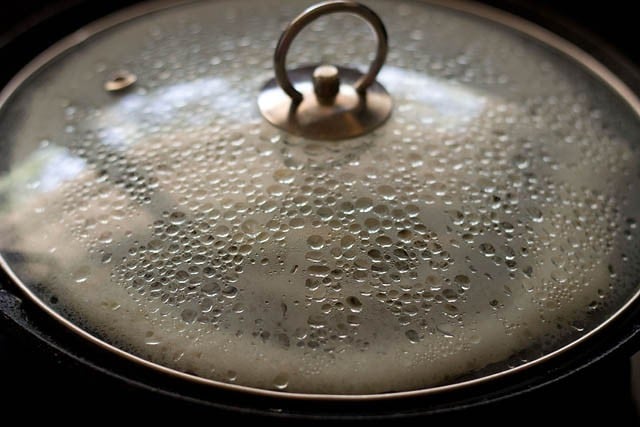

4. When the top side is cooked, spread some more oil, if you prefer, on the dosa. Spread the red chutney on the dosa all around.


5. Top the dosa with the potato palya filling and spread it lightly.


6. Fold the dosa.


7. Serve Mysore Masala Dosa hot with garlic chutney, coconut chutney and sambar.
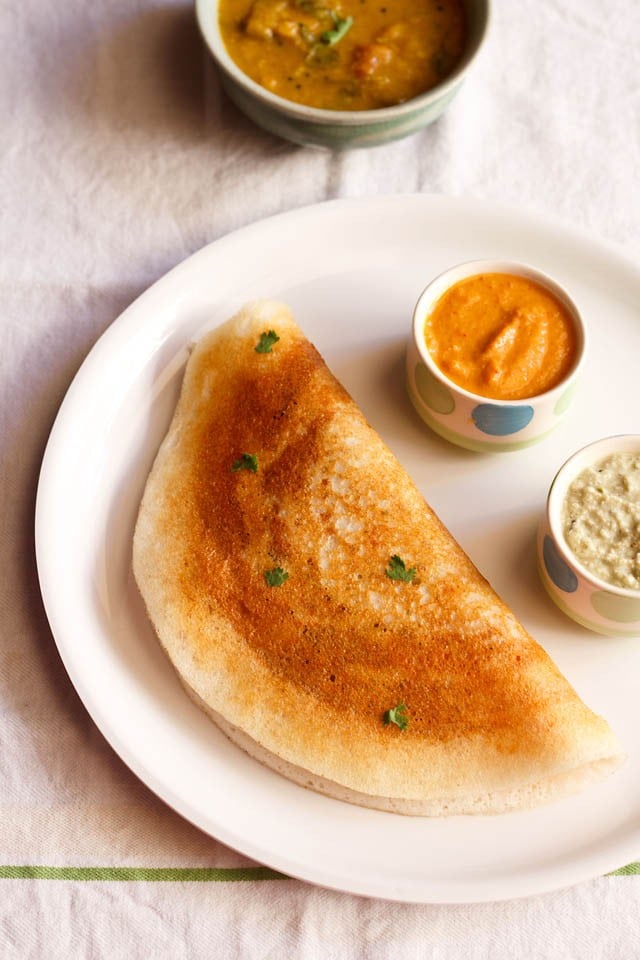

History of Mysore Masala Dosa
While it is quite obvious from the name of the dish, this special masala dosa belongs to the city of Mysore or Mysuru, Karnataka in South India. However, it just doesn’t stop here. There are quite a few stories related to the origin of the Mysore Masala Dosa.
One of the most popular beliefs is that the original Mysore Masala Dosa recipe is a patent of the Vinayaka Mylari Hotel in Mysore. It is said that the recipe of this special dosa was a secret one from the pages of the restaurant’s proprietor’s grandmother. This particular eatery has been serving this dosa for 88 years now, because of which it is also referred to as the Mylari Dosa.
There’s a typical way as well that the restaurant practices in serving this specific dosa. It always comes to your table with unsalted butter and a non-spicy coconut chutney as accompaniments. Till today, this is considered as one of the iconic places to relish this unique dosa.
According to another common legend, the Mysore Masala Dosa was a creative result from the chefs who worked for the Maharaja of Mysore.
The story states that once there was a lot of leftover food by the end of a festival hosted by the Maharaja. In order to not waste that food, he ordered his cooks to come up with an idea. As a result, they prepared dosas stuffed with the aloo masala laced with the fiery red chutney.
Expert Tips
- You can use sona masoori rice or any other regular rice to make the batter for this recipe. Just avoid using any long-grained rice.
- For a more classic restaurant style taste in the dosa, you can fry it in butter instead of oil. You can even add a dollop or two of butter to the potato filling to make it just like the ones sold on Mumbai streets.
- If you don’t want to make the dosa batter at home, you can even prepare these dosas with store-bought readymade batter. Just make sure that it is fermented well. Also, adjust the salt.
- For a variation, you can some grated cheese or paneer on the aloo stuffing.
- The leftover red chutney can also be used an accompaniment with your regular meals consisting of dal-rice, roti-sabzi, etc. or had with plain dosas, idlis, uttapams, etc.
More Dosa Recipes To Try!
Breakfast Recipes
Breakfast Recipes
Breakfast Recipes
Breakfast Recipes
Please be sure to rate the recipe in the recipe card or leave a comment below if you have made it. For more vegetarian inspirations, Sign Up for my emails or follow me on Instagram, Youtube, Facebook, Pinterest or Twitter.
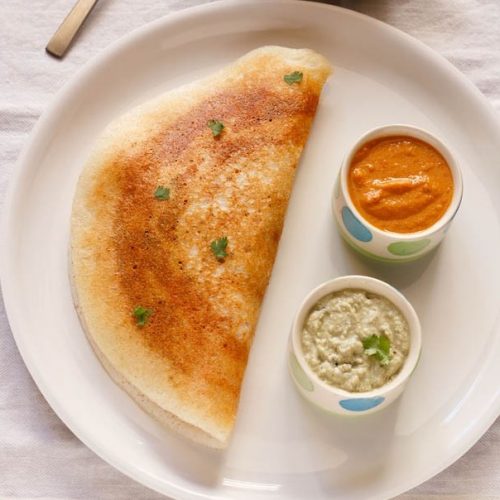

Mysore Masala Dosa (With Red Chutney)
This Mysore dosa is crisp and soft dosa spiced with red chutney and served with a potato dish, along with coconut chutney. The recipe is like the Mysore masala dosa served in the Bangalore and Mysore restaurants.
Prep Time 9 hours
Cook Time 50 minutes
Total Time 9 hours 50 minutes
ingredients for the potato palya/filling
ingredients for the red chutney
Prevent your screen from going dark while making the recipe
making batter
Pick and rinse the rice and urad dal in water for 3-4 times.
Soak the rice, urad dal and methi seeds in a large bowl in enough water for 4-5 hours.
In a wet grinder, grind the rice, urad dal, methi seeds and cooked rice or poha with enough water.
Grind till you get a fluffy and smooth consistency of the batter.
Take the dosa batter in a large bowl and mix salt.
Cover the bowl loosely and let the batter ferment for 7-9 hours.
preparing the potato palya or filling
First boil the potatoes in a steamer or pressure cooker, till they are fully cooked.
Peel and either just crumble them with your hands or chop them.
Heat oil in a pan or kadai.
First fry the mustard seeds till they splutter.
Now add the chopped onions and saute till they become soft.
Add the ginger, garlic, green chilies, curry leaves and saute for some 20-30 seconds.
Now add the turmeric powder, red chili powder and asafoetida.
Stir for 2-3 seconds and add the potatoes.
Stir and add water plus salt.
Cover and simmer the potatoes till the water dries up.
Lastly add the lemon juice and stir well.
Add coriander leaves and mix well with the potatoes.
Keep the potato palya aside.
making red chutney for dosa
making mysore masala dosa
On a tava or a flat frying pan spread 1 or 2 tsp oil. If using non stick pan, then don’t spread oil. You won’t be able to spread the dosa batter then.
Take a medium sized ladle or a big spoon and with circular motions spread the dosa from the center towards the edges on the pan.
Sprinkle some drops of oil from the top.
Cover the dosa with a lid.
Let the base get browned and the top side get cooked completely.
Spread 1 or 2 tsp of the red chili chutney on top of the dosa.
Place 2-3 tbsp of the potato stir fry on top of the mysore dosa and spread lightly.
Fold and serve the mysore masala dosa hot with coconut chutney and sambar.
Nutrition Facts
Mysore Masala Dosa (With Red Chutney)
Amount Per Serving
Calories 277 Calories from Fat 27
% Daily Value*
Fat 3g5%
Saturated Fat 1g6%
Polyunsaturated Fat 0.2g
Monounsaturated Fat 1g
Sodium 489mg21%
Potassium 284mg8%
Carbohydrates 55g18%
Fiber 5g21%
Sugar 2g2%
Protein 8g16%
Vitamin A 85IU2%
Vitamin B1 (Thiamine) 0.1mg7%
Vitamin B2 (Riboflavin) 0.05mg3%
Vitamin B3 (Niacin) 15mg75%
Vitamin B6 0.3mg15%
Vitamin C 35mg42%
Vitamin E 1mg7%
Vitamin K 2µg2%
Calcium 46mg5%
Vitamin B9 (Folate) 155µg39%
Iron 2mg11%
Magnesium 27mg7%
Phosphorus 91mg9%
Zinc 1mg7%
* Percent Daily Values are based on a 2000 calorie diet.
This Mysore Masala Dosa Recipe from the archives was first published in April 2013. It has been updated and republished in March 2024.

Source link

